UHI
"Yam is the common name
for some species in the genus
Dioscorea (family Dioscoreaceae).
They are cultivated for the consumption
of their starchy tubers in Africa, Asia,
Latin America and Oceania. They are used
in a similar fashion to potatoes and
sweet potatoes. There are hundreds of
cultivars among the cultivated species.
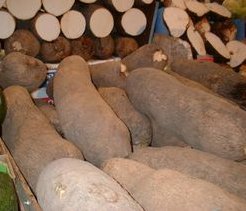
The word yam comes
from Portuguese inhame or Spanish
ñame, which both ultimately
derive from the Wolof word nyam,
meaning 'to sample' or 'taste'.
Yam tubers can grow up to
2.5 metres in length (Huxley 1992) and
weigh up to 70 kg (150 pounds). The yam
has a rough skin which is difficult to
peel, but which softens after heating.
Yam skins vary in color from dark brown
to light pink. The majority of the yam
is composed of a much softer substance
known as the 'meat'. This substance
ranges in color from white to bright
orange in ripe yams.
Yams are a primary
agricultural commodity in West Africa
and New Guinea. They were first
cultivated in Africa and Asia about 8000
B.C. To this day, the yams are important
for survival in these regions. Yam
tubers can be stored for four to six
months without refrigeration, which
makes them a valuable resource for the
yearly period of food scarcity at the
beginning of the wet season."
"Dioscorea
alata,
called water yam, winged
yam, and purple yam, was
first cultivated
somewhere in Southeast
Asia. Although it is not
grown in the same
quantities as the
African yams it has the
largest distribution
world-wide of any
cultivated yam, being
grown in Asia, the
Pacific islands, Africa,
and the West Indies
(Mignouna 2003). In the
United States it has
become an invasive
species in some Southern
states.
In the
Philippines it is known
as ube (or ubi)
and is used as an
ingredient in many sweet
desserts. In India, it
is known as ratalu
or violet yam or
the Moraga Surprise.
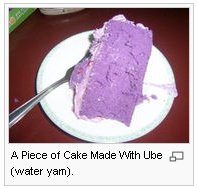
In Hawaii
it is known as uhi.
Uhi was brought to
Hawaii by the early
Polynesian settlers and
became a major crop in
the 1800s when the
tubers were sold to
visiting ships as an
easily stored food
supply for their voyages
(White 2003)."
(Internet)
Clearly uhi is a word derived from the
Philippine ubi and purple is the colour par
préference for kings.
"Ube in general refers to all
varieties, while ubi is a specific vernacular
applied to the aromatic dark-purpled 'kinampay'
found in Bohol.
Essentially, ubi is a carbohydrate
food from which starch is the main component, which is
needed mostly in processing in the world market today.
The sweet taste of ubi is due to the sugar
content such as sucrose and glucose. It is also contains
protein, carbohydrates, calcium and phosphorus as well
as moisture and energy - thus, ubi is better
compared to cassava and sweet potato.
The historical significance of the ubi
crop to the Boholanos is described by a Jesuit
missionary Father Ignacio Alcina ... in his
Historia de las Islas e indios de Bisayas (Madrid,
1668) wrote: '... the so-called ubi, which are
numerous in kind, color and shape. The larger ones are
called quinampay and are mulberry in color. The
ubi are the chief staple on the island of Bohol
and other islands (Dauis/Panglao island) where they
yield abundantly and very well.'
Bohol province boasts of being the bread
basket as the biggest rice producer in the Central
Visayas. There is more to this, however. Bohol is
recognized as the source of the rare kinampay
variety, an aromatic and velvet-colored variety,
scientifically named Dioscorea Alata Linn. Hence,
that Boholanos venerate and consider the root crop holy
has a more or less decent basis." (Internet)
Ubi is connected with a legend about a
female sun:
"... there was a beautiful royal princess
in the island of Bohol named Bugbung Humasanun, so
secluded (binokotan) in her chamber where she
could only be found spinning, weaving or embroidering.
She was adored for her coiffured panta or
talabhok, a great mass of hair accented with
artificial switches which is of great offense for a man
to even touch. Her appearance to the public was like the
first ray of the sun that gives joy and delight, or like
a sudden flash of lightning that causes fear and respect
...
A great, brave and just chief named
Datung Sumanga married her after several pangngagad
and going through ordeals to prove his love to the
princess. He ruled his subjects, settled their disputes,
protect them from the enemies, and lead them in battle.
There was peace in Bohol during his rule. From this
couple and the barangays and communities they
led, grew the population of the Boholanos." (Internet) |
|
The Dioscorea
vegetables known elsewhere as yams are generally very uncommon in these
countries. Yams are commonly confused with Sweet potatoes, although they
are not closely related. In New Zealand Sweet potatoes are commonly
referred to by their Māori name of kūmara.
Oca is one of the
important staple crops of the Andean highlands, second only to the
potato due to its easy propagation, and tolerance for poor soil, high
altitude and harsh climates.Outside of the Andean region Oxalis
tuberosa is cultivated commercially in Mexico and New Zealand.
Compared to potatoes, which are now cultivated in 130 countries around
the world, these tubers are essentially still unknown outside of the
Andean region.
Oca is usually propagated
vegetatively by planting of whole tubers. Further is propagation by
planting of cuttings, which is sometimes applied, or by seed
propagation, which is never used possible.
Oca need a long growing
season, and are day length dependent, forming tubers when the day length
shortens in autumn. In areas with harsh winter climates, early frosts
may cut back the foliage before the tubers have a chance to form. In
tropical areas where the days are unchanging in length, oca will not set
a crop successfully.
Oxalis
tuberosa is an annual plant that overwinters as underground stem
tubers. These tubers are known as oca , oka, or New
Zealand Yam.
The plant was
brought into cultivation in the central and southern Andes for its
tubers, which are used as a root vegetable. The plant is not known in
the wild, but populations of wild Oxalis species that bear
smaller tubers are known from four areas of the central Andean region.
Introduced to Europe in 1830 as a competitor to the potato and to New
Zealand as early as 1860, it has become popular in that country under
the name New Zealand yam and is now a common table vegetable.
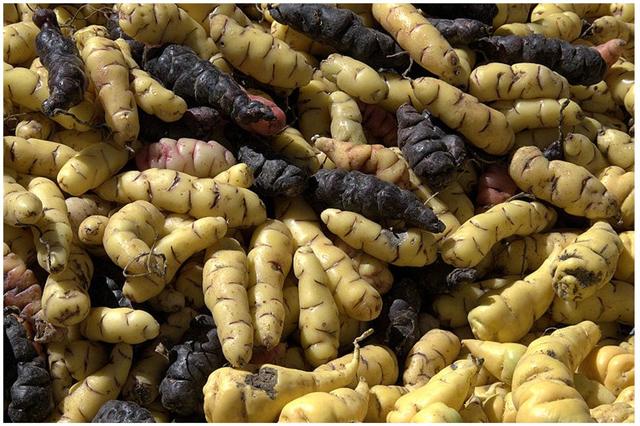
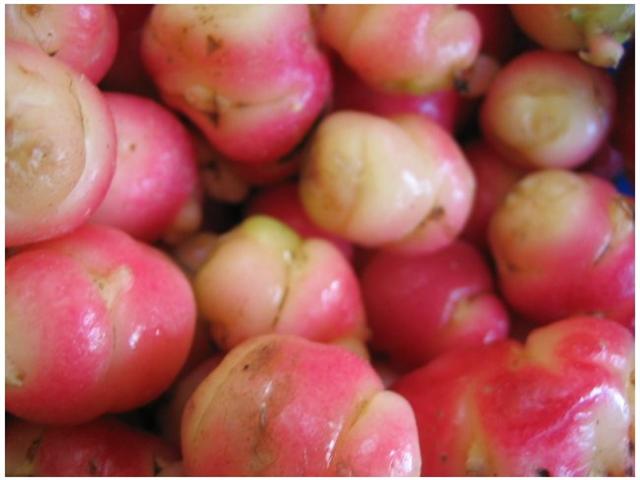
(Wikipedia) |
|
"Oxalis tuberosa
(Oxalidaceae) is a perennial herbaceous plant that overwinters as
underground stem tubers. These tubers are known as uqa in
Quechua, hispanicized oca, as New Zealand yam and a number
of other alternative names. The plant was brought into cultivation in
the central and southern Andes for its tubers, which are used as a root
vegetable. The plant is not known in the wild, but populations of wild
Oxalis species that bear smaller tubers are known from four areas
of the central Andean region. Oca was introduced to Europe in 1830 as a
competitor to the potato, and to New Zealand as early as 1860.
In New Zealand, oca has become
a popular table vegetable and is simply called yam or New Zealand yam
(although not a true yam). It is now available in a range of colours,
including yellow, orange, pink, apricot, and the traditional red.
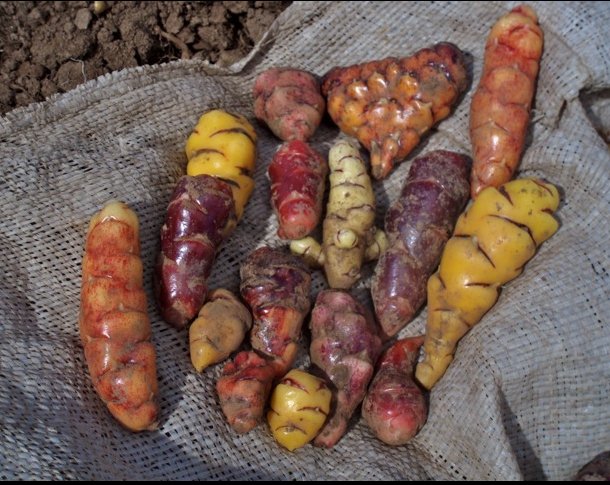
... Grown primarily by Quechua
and Aymara farmers, oca has been a staple of rural Andean diets for
centuries. Of all Andean root and tuber crops, oca is presently second
only to potato in area planted within the Central Andean region. Oca is
important to local food security because of its role in crop rotations
and its high nutritional content."
(Wikipedia) |




